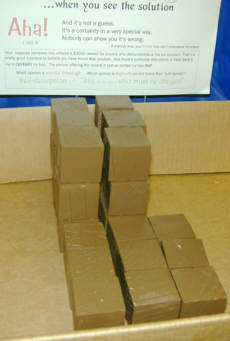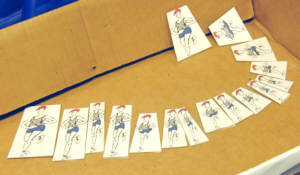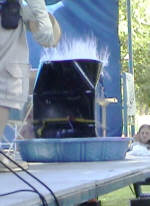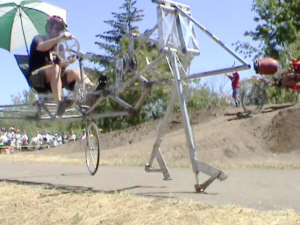|
"Though
this be madness, there be method in't"
Discovering some surprising
solution to a puzzle can be among of the most delightful of human experiences.
It's the reason most mathematicians and scientists do what they do.
But puzzles, especially
the subtle puzzles, are probably underused as a teaching tool: puzzle
solving has been found to be virtually the only route to understanding
the concepts of science and math. Those who would learn science must
follow paths similar to the paths of the pathfinders of science.
Rote memorization is the
path to writing down pi to several significant
figures, or entering a phone number on a cell phone, but rote memorization
has led almost all science and math students to a head full of useless
knowledge.
Subtle puzzles need to
be a part of the life of those who would become users
of scientific knowledge.
|
See
understanding
as the Physics Education Group at the University of Washington sees it.
See
pi
as one artist misunderstood the intent of one book publisher.
See
users
of scientific knowledge as seen by the Knowledge for Use project.
|
| . |
Future presentations of
the subtle puzzles will adopt lessons learned at this, and previous years',
Da Vinci Days |
 The
puzzle illustrates how even the most elementary math can carry powerful
insights -- and that mathematical insights sometimes require efforts of
unfamiliar kinds.
The
puzzle illustrates how even the most elementary math can carry powerful
insights -- and that mathematical insights sometimes require efforts of
unfamiliar kinds. |
Eighteen pieces can be assembled
into a cube in many different ways. But these pieces were chosen
in a peculiar way. If that peculiarity isn't discovered, assembling
the cube can be remarkably difficult.
Future presentations of this
"Cantankerous Cube" puzzle will have three presentations: 1) a "raw" puzzle
that merely asks that the pieces be assembled into a 5 X 5 X 5 cube; 2)
instructions that suggest some ways to arrange the small "stick," 1 X 1
X 3 pieces; 3) instructions that lead the puzzle solver through the arithmetical
principle that underlies the puzzle.
RAW
COOKED WELL-DONE
|
|
It's
so simple--especially when it has only the six pieces--that its solution
can be found without discovering its interesting arithmetic. But
it's surprisingly difficult for such a simple task. Discovering why
is a nice fisrt step toward seeing why even the simplest science gives
us so much difficulty.
|
Nine pieces can be assembled
into a cube. But the pieces were chosen in a peculiar way -- and
it's the same peculiarity the above puzzle has. (Three of the pieces,
small cubes, have been left out--empty spaces take their place in the assembled
cube.)
Future presentations of this
puzzle will give hints that lead the puzzle solver to the principle shared
by this and the above puzzle. |
|
|
This "Deceptive Cube" puzzle
is a variant of the Soma Cube puzzle which was popular a few decades ago.
Soma has seven pieces that make a cube, and it has over a hundred different
solutions. This variant has six pieces to make a cube, but comes
as a set of two puzzles, which...
SEE
IT
Future presentations of this
puzzle will present a variant pointing out that the pieces can be arranged
into attractive three-dimensional patterns. Perhaps amateur architects
can vie for the most popular structure as voted on by the visitors. |
|
|
An elegant
solution. It is also a "buzz-saw certain" answer to the puzzle --
it brooks no argument. Anyone who disagrees with it either doesn't
understand the problem and its answer or is redefining either the problem
or reality.
RAW
WELL-DONE
|
|
|
A
carpenter, working with a buzz saw, wishes to cut a wooden cube, three
inches on a side, into 27 one-inch cubes. He can do this job easily
by making six cuts through the cube, keeping the pieces together in the
cube shape. Can he reduce the number of necessary cuts by rearranging
the pieces after each cut? Either show how or prove that it's impossible.
Another elegant
solution...and it's the source of the term "buzz-saw certainty."
Martin Gardner gave us 25
years of subtle puzzles in his "Mathematical Games" feature of Scientific
American. This one comes from one the earliest sets of those
puzzles. Few, if any, better demonstrations of the nature of scientific
elegance can be found*. |

This
small model of the crystal structure of silicon (Diamond-Cubic structure)
introduces the important concept of spatial symmetry.
|

|

|

|

|
 |

|

|

|
This
two-fold pattern is easy to find. The square-pattern, 4-fold axis,
is the hardest to find.
|
|
4-fold
axes
|
3-fold
axes
|
2-fold
axis
|
|
|
This
is the sleeper lying among these puzzles. The principle, when seen,
has a lot of potential for reshaping our view of the world because so much
of our view lines things up for comparison. Lines are almost always
inappropriate: Multi-dimensional spaces present themselves to us and we
see lines -- somewhat like a totally colorblind sees color.
|
"Arrange
so that similarity and proximity correlate."
is
very different from "Line 'em up."
Arrange
the Athletes
|

...and the reality is actually
tensor-like |
|
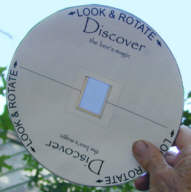 The
polarizing filters demonstrate many other interesting properties of polarized
light, including glare reduction, seeing past reflection on water, the
"Brewster angle," (which happens to be the angle of the cone of your vision
of what's outside the pool when you lay on your back on the bottom of a
swimming pool), construction of variable density filters, darkening the
sky seen by the color camera, etc.
The
polarizing filters demonstrate many other interesting properties of polarized
light, including glare reduction, seeing past reflection on water, the
"Brewster angle," (which happens to be the angle of the cone of your vision
of what's outside the pool when you lay on your back on the bottom of a
swimming pool), construction of variable density filters, darkening the
sky seen by the color camera, etc. |
The polarizing disc
instructions:
Hold the filter next to your
eye and rotate it while looking at a bit of blue sky. The blue will
darken and lighten as you rotate. Rotate to the position that makes
the sky the darkest possible. The line on the disc now points to
the sun.
You have determined the direction
of the polarization of the blue light (made blue and polarized by "Rayleigh"
scattering). You will also notice that the greatest darkening occurs
when the angle to the sun is 90o.
As the angle to the sun moves toward 0o
or 180o the darkening
lessens--no darkening at 0o
& 180o.
A bee's vision detects the
amount and direction of polarization--we have no way of knowing the bee's
experience of that detection--and knows where the sun is even if only a
small patch of blue sky is visible through the clouds. |
|
|
|
*But
do consider this one, which does have a definite numerical answer:
A wooden sphere has a cylindrical hole drilled all the way through from
surface to surface with the axis of the hole passing through the center
of the sphere. The hole is two inches long. What is the volume
of the remaining wood? |








